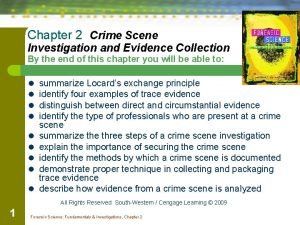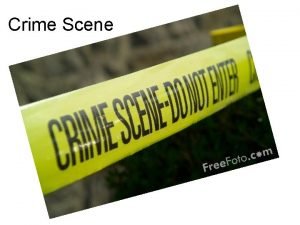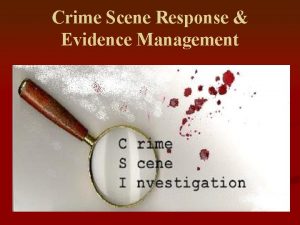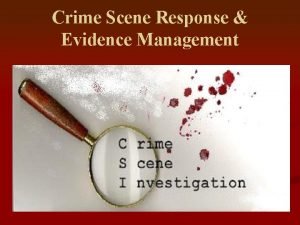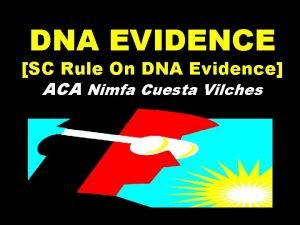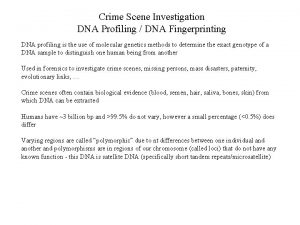DNA and Crime The Crime Evidence How can
















- Slides: 16

DNA and Crime

The Crime…

Evidence How can we solve this TERRIBLE crime? !? What evidence is available? What can we do with it?

Polymerase Chain Reaction - What is it? • PCR is a process whereby millions of copies of small segments of DNA are made from an original piece • Technology was first developed in the 1980 s • Commonly used in biological or medical research, as well as during crime scene investigations

How Does PCR Work? In order to carry out a polymerase chain reaction, you need: 1. The target sample – a piece of DNA 2. A primer - Short strands of DNA that adhere to the target segment. They identify the portion of DNA to be multiplied and provide a starting place for replication. 3. Taq polymerase - This is the enzyme that is in charge of replicating DNA. This is the polymerase part of the name polymerase chain reaction. 4. Nucleotides - You'll need to add nucleotides (d. NTPs) so the DNA polymerase has building blocks to work with.

How does PCR Work? There are 3 steps to PCR: • Denaturing – The DNA is heated which separates the two strands into one • Annealing – the sample is cooled, which allows the primers to join the sample • Extending – the temperature is once again raised and the Taq polymerase enzyme makes the new strand of DNA This is repeated multiple times!



Gel Electrophoresis Gel electrophoresis is a laboratory method used to separate mixtures of DNA, RNA, or proteins according to molecular size.

Why is this important? Gel Electrophoresis allows to to determine the different lengths of DNA, and allows us to actually view the DNA sequence


Activity Back to our crime scene…. . http: //www. pbslearningmedia. org/asset/tdc 02_ int_creatednafp 2/

How reliable is DNA Evidence?

Is DNA evidence foolproof? - We share 99. 99% of of DNA with others - DNA can be found in blood, hair, skin, saliva, and semen -It is easier to exclude a suspect based on DNA evidence than it is to convict -relatives have more matching DNA bases than unrelated people -human error

Activity – Who Stole the Cheese? • Method of Entry: Unknown, no evidence of force on doors or windows. • Narrative: The cheese was allegedly stolen from the Queen's sitting room the night before the grand ball. The cheese was listed as a gift from the Manchurian diplomat. Officer Li Gase dusted for fingerprints and found none on the table or doors, the maid claimed that they had been wiped clean earlier. The wheel of cheese was on a platform in the sitting room, and half of it had been eaten. We took pictures of the half eaten cheese and sent it to the lab for further tests. Edna N. Zime, the lab technician said that saliva samples could be taken from the teeth imprints of the cheese that was left behind.

Activity Instructions 1. The restriction enzyme cuts at ever point it finds CCGG, always cutting between the C and the G. Draw a line between C and G every place you see CCGG. 2. Count the number of pairs in your sequence. 3. For the data and the suspects, colour in the box on the chart that corresponds with the base pairs for your data or suspect. Eg: 10 8 7 6 7
 Why is fiber considered class evidence
Why is fiber considered class evidence Coding dna and non coding dna
Coding dna and non coding dna Summarize locard's principle of exchange
Summarize locard's principle of exchange Difference between class and individual evidence
Difference between class and individual evidence Dna polymerase function in dna replication
Dna polymerase function in dna replication Bioflix activity dna replication lagging strand synthesis
Bioflix activity dna replication lagging strand synthesis Enzyme involved in dna replication
Enzyme involved in dna replication Dna rna protein synthesis homework #2 dna replication
Dna rna protein synthesis homework #2 dna replication Evidence crime scene
Evidence crime scene Secondary sources
Secondary sources Primary evidence vs secondary evidence
Primary evidence vs secondary evidence Primary evidence vs secondary evidence
Primary evidence vs secondary evidence Primary evidence vs secondary evidence
Primary evidence vs secondary evidence Jobs vancouver
Jobs vancouver Class evidence vs individual evidence
Class evidence vs individual evidence A pair of latex gloves was found at a crime scene
A pair of latex gloves was found at a crime scene Define ecological fallacy
Define ecological fallacy


